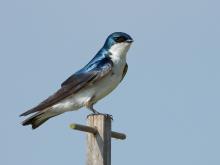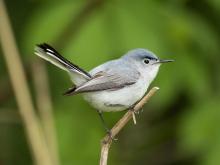Birds
Media

Species Types
Scientific Name
Himantopus mexicanus
Description
The black-necked stilt migrates through Missouri in spring and fall. In summer, it breeds locally in the Bootheel. It’s easy to identify, with its black back, white belly, long pink legs, and long, thin, straight bill.
Media

Species Types
Scientific Name
Tachycineta bicolor
Description
Tree swallows are sleek, agile fliers with white underparts and dark upperparts that look glossy blue or blue-green in good light. They are common migrants in Missouri. People most often see them chasing flying insects over wetlands and other aquatic habitats.
Media

Species Types
Scientific Name
Riparia riparia
Description
Bank swallows are brown above and white below, with a dark brown band across the breast. In Missouri, they are a locally common summer resident, nesting in holes they excavate in steep mud embankments.
Media

Species Types
Scientific Name
Stelgidopteryx serripennis
Description
Northern rough-winged swallows are sleek, agile fliers with brown upperparts, brownish-white throat, and whitish underparts. They are common summer residents in Missouri. People most often see them chasing flying insects over land or water.
Media

Species Types
Scientific Name
Sitta pusilla
Description
Years of planning have brought the brown-headed nuthatch back to the pine-woodlands of southern Missouri. Their calls sound like rubber duckies: squeaka squeaka! These tiny birds with chisel bills creep on pine branches.
Media

Species Types
Scientific Name
Sitta canadensis
Description
The red-breasted nuthatch is an uncommon winter resident in Missouri’s pine forests. It has rusty underparts and a bold white stripe above the black eye line. Its song is like the white-breasted-nuthatch’s but is higher-pitched: “wak, wak, wak, wak, wak.”
Media

Species Types
Scientific Name
Ictinia mississippiensis
Description
The Mississippi kite is a rare summer resident in Missouri, usually seen flying above forests and grasslands along the Mississippi River valley. The flight of this rather small raptor is buoyant, like that of a swallow, or, yes, a kite.
Media

Species Types
Scientific Name
Polioptila caerulea
Description
Male blue-gray gnatcatchers are bluish gray and females are gray. The underparts are pale gray. The tail is black with white outer feathers, so when folded it appears white from below. There is a white eye ring. Common summer residents in Missouri, they habitually jerk their tails from side to side.
Media

Species Types
Scientific Name
Sterna forsteri
Description
Adult Forster’s terns are pale gray above and white below, with a deeply forked gray tail and black markings on the head. There are different breeding and nonbreeding colorations. In Missouri, this species is a common spring and fall transient and an uncommon winter resident.
Media

Species Types
Scientific Name
Setophaga coronata (formerly Dendroica coronata)
Description
The yellow-rumped warbler is Missouri’s most abundant migrant warbler. It is also seen in winter. Adults have a yellow patch on the rump, the crown, and the sides near the bend of the wing.
See Also







Media

Species Types
Scientific Name
Hemaris diffinis
Description
The snowberry clearwing is a moth that confuses people because it looks like a bumblebee and flies like a hummingbird!
Media

Species Types
Scientific Name
Hyles lineata
Description
The white-lined sphinx moth sometimes confuses people because it flies, hovers, and eats from flowers like a hummingbird. The adults often fly during daylight hours as well as in the night and are often found at lights.
Media

Species Types
Scientific Name
Darapsa myron
Description
The Virginia creeper sphinx moth is common in woods and brushy areas and comes to lights at night. The larvae eat Virginia creeper and grape leaves.
Media

Species Types
Scientific Name
Perimyotis subflavus (formerly Pipistrellus subflavus)
Description
Tri-colored bats, formerly called eastern pipistrelles, are relatively small and look pale yellowish or pale reddish brown. The main hairs are dark gray at the base, broadly banded with yellowish brown, and tipped with dark brown.
Media

Species Types
Scientific Name
Myotis grisescens
Description
Gray myotises are difficult to distinguish from other mouse-eared bats. A key identifying feature of the gray myotis is that its wing is attached to the ankle and not at the base of the toes. It’s an endangered species.
Media

Species Types
Scientific Name
Myotis lucifugus
Description
The little brown myotis (little brown bat) is one of our most common bats, but populations are declining. White-nose syndrome has taken a heavy toll in northeastern states. This species is now listed as vulnerable across its range.
Media

Species Types
Scientific Name
Myotis sodalis
Description
The Indiana myotis, or Indiana bat, summers along streams and rivers in north Missouri, raising its young under the bark of certain trees. It is an endangered species.
About Birds in Missouri
About 350 species of birds are likely to be seen in Missouri, though nearly 400 have been recorded within our borders. Most people know a bird when they see one — it has feathers, wings, and a bill. Birds are warm-blooded, and most species can fly. Many migrate hundreds or thousands of miles. Birds lay hard-shelled eggs (often in a nest), and the parents care for the young. Many communicate with songs and calls.





















